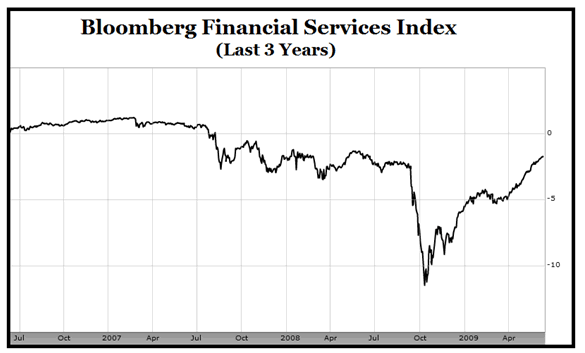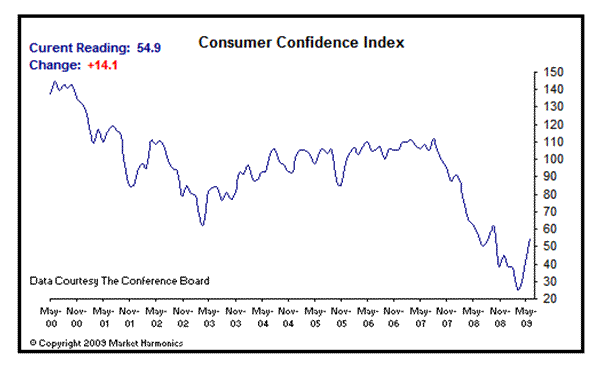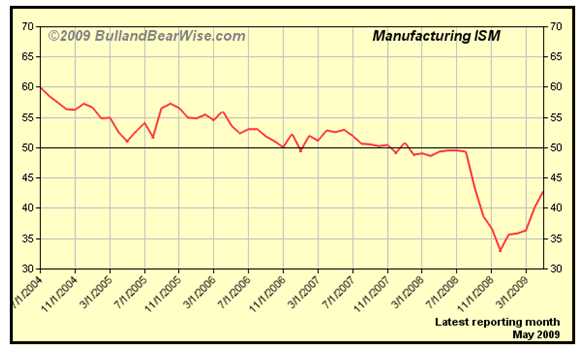Is Economic Recovery Closer Than You Think?
Economics / US Economy Jun 16, 2009 - 01:41 AM GMTBy: Q1_Publishing
 The divide between bull and bear camps is growing wider each day.
The divide between bull and bear camps is growing wider each day.
There isn’t much middle ground. You’re either in it, waiting for a pullback, or waiting for the collapse.
Despite the divide, the market shows considerable strength. And the big question remains, “Where are the markets headed from here?”
Frankly, there’s still no easy answer. This is the stock market. It’s nearly impossible to predict what is going to happen in the short-term. That doesn’t mean it’s impossible to tell. We just have to find the right sources of information. As usual, the mainstream press is little help.
The Wall Street Journal points out “stocks [are] in the black on gusher of cash.”
The latest Barron’s warns the recent rally has gone “too far, too fast.”
Not much clarification there. But if you look beyond the headlines, you can get a good idea of what’s likely to happen. And that’s what’s important. Figuring out what is likely to happen. Then get positioned.
The Bull Picks up Speed
The best catalyst for a market rise will come from improving investor confidence. All signs point to it continuing to rise.
Retail investors continue to get in on the action. Last week marked the 12th week in a row investors put more money into mutual funds. The Investment Company Institute said another $13.6 billion was poured into mutual funds last week. The increase was broad too. It spread across equity, international, and bond funds.
Institutional investors are starting to get on board too. The last Investor’s Intelligence survey puts bullish sentiment at 47.7%. It pegged bearish sentiment at 23.3%. That works out to two bulls for every bear.
It seems investors’ willingness to dip their toes back in the market waters is growing consistently. But investors are fickle. Confidence can evaporate quickly. So despite the positive sentiment, we’ve reached a point where the economy needs to show some genuine signs of recovery before they plow a lot of money back into the markets.
The following three charts show there could be a recovery sooner rather than later. And they help show why I believe this rally has a lot more gas left in the tank than most people think.
Financial Services on the Mend
We’ve come a long way in the past few months. The financial services industry has been leading the way.
The sharp recovery of the Bloomberg Financial Services Index (Hat tip: Mark Perry at Carpe Diem blog) shows a recovery is just around the corner.
The Bloomberg Financial Services Index is “a useful gauge to assess banking and lending conditions and the availability of credit in the United States.” So when the index is up, access to credit is high. When the index is down, access to credit is low. As you can see in the chart below, the index access to credit has been recovering quickly.

The index has been slowly working its way back to normal. It’s even getting close to late 2007 levels. That was a time when the market was getting its first whiff of the problems in the banking sector.
Credit flowing again is just part of the story here though. Another big benefit of the financial services industry getting moving again is a lot of people will get paid.
Remember, financial services play a large role in the U.S. economy. Decades of “financialization” have made the financial services industry an integral part of the economy. At the height of the bubble, 4.5% of all workers, 7.5% of all compensation, and 8% of total GDP all came from financial services. That’s why there must be a recovery in the financial services industry for economic growth to turn positive in the short term. It’s just such a big part.
Of course, it’s not just financial services which need to get back to normal. Consumers need to start spending again too.
Buying Our Way Out
The consumer-centric U.S. economy is not going to change overnight. Sure, people have started saving again. They’re paying down debts. And they’re (generally) acting more responsibly. They’re also starting to spend again too.
The shopping itch is back. The chart below from Market Harmonics shows consumers are more willing than they have been in months to scratch it.

Last month marked the third straight month of rising consumer confidence. Granted the rebound has been from rock-bottom lows, but it’s a rise back to pre-credit crunch levels.
This is important because consumer confidence moves in long sweeping trends. Basically, the long trends mean consumer confidence is part of a self-reinforcing cycle. As some consumers start shopping again, more follow. The more consumer confidence rises, the more consumers get on board.
It’s all part of a virtuous cycle. So if this uptrend is sustainable, it can stay steadily rising for a long time to come.
Just like financial services and credit availability, consumer confidence is just one part of a bigger economic puzzle. Another key part, manufacturing, has to return to a somewhat normal level as well.
Manufacturing a Recovery
Although manufacturing has steadily become a smaller part of the U.S. economy, it’s still an important part. That’s why it’s another good sign to see the early markings of a recovery in manufacturing activity.
In the chart below, you can see how the decline in manufacturing activity is starting to slow.

The chart tracks the monthly Institute for Supply Management’s manufacturing activity index. A reading above 50 means manufacturing activity is increasing. A reading below 50 means manufacturing activity is decreasing.
The chart shows manufacturing activity has declined every month for over a year. The decline started with a slight contraction. Then when the credit crunch hit, manufacturing activity plummeted.
The bad news is manufacturing activity still hasn’t recovered.
The good news is manufacturing activity is closer to a recovery now than it has been in the past nine months. The improving trend shows how there could realistically be an increase in manufacturing activity before the end of 2009.
Although it’s hardly one of the “green shoots” yet, any monthly uptick in manufacturing activity would be welcomed greatly by the markets.
It’s All About Odds
And that’s what really matters here, the markets. We want to know where the markets are going. So with all investors’ eyes on the economy, that’s where we’ll need to focus.
The way things look, the economy is showing improving signs of strength. With credit flowing again, the financial services showing signs of “normalization,” consumer confidence increasing, and the manufacturing sector on the mend, the prospect of a recovery is very real.
That’s why I encourage you to look past the week to week economic data. The short-term readings can make some interesting headlines, but the trends are what matters most. Right now, the negative economic trends are reversing. And we can’t rule out a couple of quarters of GDP growth over the horizon.
It’s all a big reason why odds of the next market move being higher – especially as the major indices sit 40% below their all-time highs.
In the end, we can’t forget investing is all about odds and analyzing risk and reward. According to the three indicators we went over today, the odds of seeing some official GDP growth within the next year are rising steadily. Along with further economic improvement, will come improved earnings, employment, and another leg up for the markets.
From a risk and reward perspective, a continued economic recovery and market rally make quite a few sectors attractive. Although it’s tough to find a specific sector which hasn’t participated in the rally, there are some which still offer some very good values.
So whether you consider yourself in the bull or bear camp, take the conservative steps to position yourself for where the market is likely headed.
Good investing,
Andrew Mickey
Chief Investment Strategist, Q1 Publishing
Disclosure: Author currently holds a long position in Silvercorp Metals (SVM), physical silver, and no position in any of the other companies mentioned.
Q1 Publishing is committed to providing investors with well-researched, level-headed, no-nonsense, analysis and investment advice that will allow you to secure enduring wealth and independence.
© 2009 Copyright Q1 Publishing - All Rights Reserved
Disclaimer: The above is a matter of opinion provided for general information purposes only and is not intended as investment advice. Information and analysis above are derived from sources and utilising methods believed to be reliable, but we cannot accept responsibility for any losses you may incur as a result of this analysis. Individuals should consult with their personal financial advisors.
Q1 Publishing Archive |
© 2005-2022 http://www.MarketOracle.co.uk - The Market Oracle is a FREE Daily Financial Markets Analysis & Forecasting online publication.



